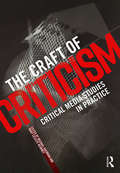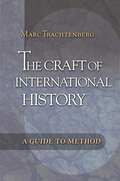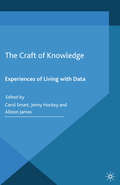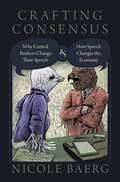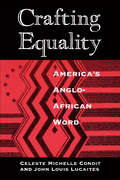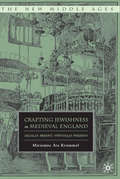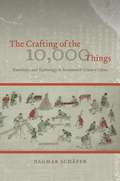- Table View
- List View
Craft Economies
by Susan Luckman Nicola ThomasCraft Economies provides a wide-ranging exploration of contemporary craft production, situating practices of amateur and professional making within a wider creative economy. Contributors address a diverse range of practices, sites and forms of making in a wide range of regional and national contexts, from floristry to ceramics and from crochet to coding. The volume considers the role of digital practices of making and the impact of the maker's movement as part of larger trends around customisation, on-demand production, and the possibilities of 3D printing and digital manufacturing.
Craft Guilds in the Early Modern Low Countries: Work, Power, and Representation
by Catharina Lis Hugo SolyIn the half millennium of their existence, guilds in the Low Countries played a highly significant role in shaping the societies of which they were a part. One key aspect that has been identified in recent historical research to explain the survival of the guilds for such a long time is the guilds' continued adaptability to changing circumstances. This idea of flexibility is the point of departure for the essays in this volume, which sheds new light on the corporate system and identifies its various features and regional variances. The contributors explore the interrelations between economic organisations and political power in late medieval and early modern towns, and address issues of gender, religion and social welfare in the context of the guilds. This cohesive and focussed volume will provide a stimulus for renewed interest and further research in this area. It will appeal to scholars and students with an interest in early modern economic, social and cultural history in particular, but will also be valuable to those researching into political, religious and gender history.
Craft Guilds in the Early Modern Low Countries: Work, Power, and Representation
by Catharina Lis Hugo SolyIn the half millennium of their existence, guilds in the Low Countries played a highly significant role in shaping the societies of which they were a part. One key aspect that has been identified in recent historical research to explain the survival of the guilds for such a long time is the guilds' continued adaptability to changing circumstances. This idea of flexibility is the point of departure for the essays in this volume, which sheds new light on the corporate system and identifies its various features and regional variances. The contributors explore the interrelations between economic organisations and political power in late medieval and early modern towns, and address issues of gender, religion and social welfare in the context of the guilds. This cohesive and focussed volume will provide a stimulus for renewed interest and further research in this area. It will appeal to scholars and students with an interest in early modern economic, social and cultural history in particular, but will also be valuable to those researching into political, religious and gender history.
Craft is Political
by D WoodThroughout the 21st century, various craft practices have drawn the attention of academics and the general public in the West. In Craft is Political, D Wood has gathered a collection of essays to argue that this attention is a direct response to and critique of the particular economic, social and technological contexts in which we live.Just as Ruskin and Morris viewed craft and its ethos in the 1800s as a kind of political opposition to the Industrial Revolution, Wood and her authors contend that current craft activities are politically saturated when perspectives from the Global South, Indigenous ideology and even Western government policy are examined. Craft is Political argues that a holistic perspective on craft, in light of colonialism, post-colonialism, critical race theory and globalisation, is overdue.A great diversity of case studies is included, from craft and design in Turkey and craft markets in New Zealand to Indigenous practitioners in Taiwan and Finnish craft education. Craft is Political brings together authors from a variety of disciplines and nations to consider politicised craft.
Craft is Political
by D WoodThroughout the 21st century, various craft practices have drawn the attention of academics and the general public in the West. In Craft is Political, D Wood has gathered a collection of essays to argue that this attention is a direct response to and critique of the particular economic, social and technological contexts in which we live.Just as Ruskin and Morris viewed craft and its ethos in the 1800s as a kind of political opposition to the Industrial Revolution, Wood and her authors contend that current craft activities are politically saturated when perspectives from the Global South, Indigenous ideology and even Western government policy are examined. Craft is Political argues that a holistic perspective on craft, in light of colonialism, post-colonialism, critical race theory and globalisation, is overdue.A great diversity of case studies is included, from craft and design in Turkey and craft markets in New Zealand to Indigenous practitioners in Taiwan and Finnish craft education. Craft is Political brings together authors from a variety of disciplines and nations to consider politicised craft.
The Craft of Criticism: Critical Media Studies in Practice
by Michael Kackman Mary Celeste KearneyWith contributions from 30 leading media scholars, this collection provides a comprehensive overview of the main methodologies of critical media studies. Chapters address various methods of textual analysis, as well as reception studies, policy, production studies, and contextual, multi-method approaches, like intertextuality and cultural geography. Film and television are at the heart of the collection, which also addresses emergent technologies and new research tools in such areas as software studies, gaming, and digital humanities. Each chapter includes an intellectual history of a particular method or approach, a discussion of why and how it was used to study a particular medium or media, relevant examples of influential work in the area, and an in-depth review of a case study drawn from the author's own research. Together, the chapters in this collection give media critics a complete toolbox of essential critical media studies methodologies.
The Craft of Criticism: Critical Media Studies in Practice
by Mary Celeste Kearney Michael KackmanWith contributions from 30 leading media scholars, this collection provides a comprehensive overview of the main methodologies of critical media studies. Chapters address various methods of textual analysis, as well as reception studies, policy, production studies, and contextual, multi-method approaches, like intertextuality and cultural geography. Film and television are at the heart of the collection, which also addresses emergent technologies and new research tools in such areas as software studies, gaming, and digital humanities. Each chapter includes an intellectual history of a particular method or approach, a discussion of why and how it was used to study a particular medium or media, relevant examples of influential work in the area, and an in-depth review of a case study drawn from the author's own research. Together, the chapters in this collection give media critics a complete toolbox of essential critical media studies methodologies.
The Craft of International History: A Guide to Method
by Marc TrachtenbergThis is a practical guide to the historical study of international politics. The focus is on the nuts and bolts of historical research--that is, on how to use original sources, analyze and interpret historical works, and actually write a work of history. Two appendixes provide sources sure to be indispensable for anyone doing research in this area. The book does not simply lay down precepts. It presents examples drawn from the author's more than forty years' experience as a working historian. One important chapter, dealing with America's road to war in 1941, shows in unprecedented detail how an interpretation of a major historical issue can be developed. The aim throughout is to throw open the doors of the workshop so that young scholars, both historians and political scientists, can see the sort of thought processes the historian goes through before he or she puts anything on paper. Filled with valuable examples, this is a book anyone serious about conducting historical research will want to have on the bookshelf.
The Craft of International History: A Guide to Method
by Marc TrachtenbergThis is a practical guide to the historical study of international politics. The focus is on the nuts and bolts of historical research--that is, on how to use original sources, analyze and interpret historical works, and actually write a work of history. Two appendixes provide sources sure to be indispensable for anyone doing research in this area. The book does not simply lay down precepts. It presents examples drawn from the author's more than forty years' experience as a working historian. One important chapter, dealing with America's road to war in 1941, shows in unprecedented detail how an interpretation of a major historical issue can be developed. The aim throughout is to throw open the doors of the workshop so that young scholars, both historians and political scientists, can see the sort of thought processes the historian goes through before he or she puts anything on paper. Filled with valuable examples, this is a book anyone serious about conducting historical research will want to have on the bookshelf.
The Craft of Knowledge: Experiences of Living with Data
by Allison James Carol Smart Jenny HockeyThis book is a contribution to contemporary debates on social research with a unique focus on the relationship between methods and the crafting of knowledge. Nine experienced researchers from different disciplines have come together to explore what really matters to them in the process of doing qualitative research.
Crafted in Britain: The Survival of Britain's Traditional Industries
by Anthony Burton Mr Rob ScottCrafted in Britain is a celebration of Britain's traditional crafts and industries that have survived into the modern world, not as museums but on their merits. In an age of increasing automation and standardisation, it is a joy to find such places, where craftsmanship and personal skills are still valued. Their world is recreated in Rob Scott's dramatic photographs, while the processes and history of the different industries is described in the accompanying text by Anthony Burton. They have travelled the country from the Spey valley in Scotland, where they recorded the workers in a traditional distillery and a cooperage, to Cornwall and the studio of a specialist pub sign painter. They have gone underground with a Free Miner of the Forest of Dean and seen molten metal being poured to create majestic church bells. The book delights in the variety and individuality of the different industries. For both author and photographer it has been a revelation to see some of these processes at work: to watch a craftsman take a strip of silver and work it by hand into a spoon, or to find clocks being made in a workshop that looks as if it has scarcely changed for a hundred years. Now readers have the opportunity to share these experiences and delight in the discovery of these magnificent survivors.
Crafted in Britain: The Survival of Britain's Traditional Industries
by Anthony Burton Rob ScottCrafted in Britain is a celebration of Britain's traditional crafts and industries that have survived into the modern world, not as museums but on their merits. In an age of increasing automation and standardisation, it is a joy to find such places, where craftsmanship and personal skills are still valued. Their world is recreated in Rob Scott's dramatic photographs, while the processes and history of the different industries is described in the accompanying text by Anthony Burton. They have travelled the country from the Spey valley in Scotland, where they recorded the workers in a traditional distillery and a cooperage, to Cornwall and the studio of a specialist pub sign painter. They have gone underground with a Free Miner of the Forest of Dean and seen molten metal being poured to create majestic church bells. The book delights in the variety and individuality of the different industries. For both author and photographer it has been a revelation to see some of these processes at work: to watch a craftsman take a strip of silver and work it by hand into a spoon, or to find clocks being made in a workshop that looks as if it has scarcely changed for a hundred years. Now readers have the opportunity to share these experiences and delight in the discovery of these magnificent survivors.
Crafting an Indigenous Nation: Kiowa Expressive Culture in the Progressive Era
by Jenny Tone-Pah-HoteIn this in-depth interdisciplinary study, Jenny Tone-Pah-Hote reveals how Kiowa people drew on the tribe's rich history of expressive culture to assert its identity at a time of profound challenge. Examining traditional forms such as beadwork, metalwork, painting, and dance, Tone-Pah-Hote argues that their creation and exchange were as significant to the expression of Indigenous identity and sovereignty as formal political engagement and policymaking. These cultural forms, she argues, were sites of contestation as well as affirmation, as Kiowa people used them to confront external pressures, express national identity, and wrestle with changing gender roles and representations. Combatting a tendency to view Indigenous cultural production primarily in terms of resistance to settler-colonialism, Tone-Pah-Hote expands existing work on Kiowa culture by focusing on acts of creation and material objects that mattered as much for the nation's internal and familial relationships as for relations with those outside the tribe. In the end, she finds that during a time of political struggle and cultural dislocation at the turn of the twentieth century, the community's performative and expressive acts had much to do with the persistence, survival, and adaptation of the Kiowa nation.
Crafting Consensus: Why Central Bankers Change Their Speech and How Speech Changes the Economy
by Nicole BaergIn a world dependent on the constant sharing of information, central bankers increasingly communicate their policies to the mass public. Central bank communications are drafted in monetary policy committee meetings composed of policymakers with differing interests. Despite their differences, committee members must come together, write, and agree to an official policy statement. Once released to the public, central bank communications then affect citizens' actions and ultimately, the economy. But how exactly does this work? In Crafting Consensus, Nicole Baerg explains how the transparency of central bank communication depends on the configuration of committee members' preferences. Baerg argues that monetary policy committees composed of members with differing preferences over inflation are better suited to communicating precise information with the public. These diverse committees produce central bank statements of higher quality and less uncertainty than those from more homogeneous committees. Additionally, she argues that higher quality statements more effectively shape individuals' inflation expectations and move the economy in ways that policymakers intend. Baerg demonstrates that central bankers are not impartial technocrats and that their preferences and the institutional rules where they work matter for understanding the politics of monetary policy and variations in economic performance over time. Conducting empirical analysis from historical archival data, textual analysis, machine-learning, survey experiments, and cross-sectional time-series data, Crafting Consensus offers a new theory of committee decision making and a battery of empirical tests to provide a rich understanding of modern-day central banking.
Crafting Consensus: Why Central Bankers Change Their Speech and How Speech Changes the Economy
by Nicole BaergIn a world dependent on the constant sharing of information, central bankers increasingly communicate their policies to the mass public. Central bank communications are drafted in monetary policy committee meetings composed of policymakers with differing interests. Despite their differences, committee members must come together, write, and agree to an official policy statement. Once released to the public, central bank communications then affect citizens' actions and ultimately, the economy. But how exactly does this work? In Crafting Consensus, Nicole Baerg explains how the transparency of central bank communication depends on the configuration of committee members' preferences. Baerg argues that monetary policy committees composed of members with differing preferences over inflation are better suited to communicating precise information with the public. These diverse committees produce central bank statements of higher quality and less uncertainty than those from more homogeneous committees. Additionally, she argues that higher quality statements more effectively shape individuals' inflation expectations and move the economy in ways that policymakers intend. Baerg demonstrates that central bankers are not impartial technocrats and that their preferences and the institutional rules where they work matter for understanding the politics of monetary policy and variations in economic performance over time. Conducting empirical analysis from historical archival data, textual analysis, machine-learning, survey experiments, and cross-sectional time-series data, Crafting Consensus offers a new theory of committee decision making and a battery of empirical tests to provide a rich understanding of modern-day central banking.
Crafting Equality: America's Anglo-African Word (New Practices of Inquiry)
by Celeste Michelle Condit John Louis LucaitesPhilosophers and historians often treat fundamental concepts like equality as if they existed only as fixed ideas found solely in the canonical texts of civilization. In Crafting Equality, Celeste Michelle Condit and John Louis Lucaites argue that the meaning of at least one key word—equality—has been forged in the day-to-day pragmatics of public discourse. Drawing upon little studied speeches, newspapers, magazines, and other public discourse, Condit and Lucaites survey the shifting meaning of equality from 1760 to the present as a process of interaction and negotiation among different social groups in American politics and culture. They make a powerful case for the critical role of black Americans in actively shaping what equality has come to mean in our political conversation by chronicling the development of an African-American rhetorical community. The story they tell supports a vision of equality that embraces both heterogeneity and homogeneity as necessary for maintaining the balance between liberty and property. A compelling revision of an important aspect of America's history, Crafting Equality will interest anyone wanting to better understand the role public discourse plays in affecting the major social and political issues of our times. It will also interest readers concerned with the relationship between politics and culture in America's increasingly multi-cultural society.
Crafting Equality: America's Anglo-African Word (New Practices of Inquiry)
by Celeste Michelle Condit John Louis LucaitesPhilosophers and historians often treat fundamental concepts like equality as if they existed only as fixed ideas found solely in the canonical texts of civilization. In Crafting Equality, Celeste Michelle Condit and John Louis Lucaites argue that the meaning of at least one key word—equality—has been forged in the day-to-day pragmatics of public discourse. Drawing upon little studied speeches, newspapers, magazines, and other public discourse, Condit and Lucaites survey the shifting meaning of equality from 1760 to the present as a process of interaction and negotiation among different social groups in American politics and culture. They make a powerful case for the critical role of black Americans in actively shaping what equality has come to mean in our political conversation by chronicling the development of an African-American rhetorical community. The story they tell supports a vision of equality that embraces both heterogeneity and homogeneity as necessary for maintaining the balance between liberty and property. A compelling revision of an important aspect of America's history, Crafting Equality will interest anyone wanting to better understand the role public discourse plays in affecting the major social and political issues of our times. It will also interest readers concerned with the relationship between politics and culture in America's increasingly multi-cultural society.
Crafting Equality: America's Anglo-African Word (New Practices of Inquiry)
by Celeste Michelle Condit John Louis LucaitesPhilosophers and historians often treat fundamental concepts like equality as if they existed only as fixed ideas found solely in the canonical texts of civilization. In Crafting Equality, Celeste Michelle Condit and John Louis Lucaites argue that the meaning of at least one key word—equality—has been forged in the day-to-day pragmatics of public discourse. Drawing upon little studied speeches, newspapers, magazines, and other public discourse, Condit and Lucaites survey the shifting meaning of equality from 1760 to the present as a process of interaction and negotiation among different social groups in American politics and culture. They make a powerful case for the critical role of black Americans in actively shaping what equality has come to mean in our political conversation by chronicling the development of an African-American rhetorical community. The story they tell supports a vision of equality that embraces both heterogeneity and homogeneity as necessary for maintaining the balance between liberty and property. A compelling revision of an important aspect of America's history, Crafting Equality will interest anyone wanting to better understand the role public discourse plays in affecting the major social and political issues of our times. It will also interest readers concerned with the relationship between politics and culture in America's increasingly multi-cultural society.
Crafting History: Archiving and the Quest for Architectural Legacy (Expertise: Cultures and Technologies of Knowledge)
by Albena YanevaWhat constitutes an archive in architecture? What forms does it take? What epistemology does it perform? What kind of craft is archiving? Crafting History provides answers and offers insights on the ontological granularity of the archive and its relationship with architecture as a complex enterprise that starts and ends much beyond the act of building or the life of a creator. In this book we learn how objects are processed and catalogued, how a classification scheme is produced, how models and drawings are preserved, and how born-digital material battles time and technology obsolescence. We follow the work of conservators, librarians, cataloguers, digital archivists, museum technicians, curators, and architects, and we capture archiving in its mundane and practical course. Based on ethnographic observation at the Canadian Centre for Architecture and interviews with a range of practitioners, including Álvaro Siza and Peter Eisenman, Albena Yaneva traces archiving through the daily work and care of all its participants, scrutinizing their variable ontology, scale, and politics. Yaneva addresses the strategies practicing architects employ to envisage an archive-based future and tells a story about how architectural collections are crafted so as to form the epistemological basis of architectural history.
Crafting identities: Artisan culture in London, <i>c.</i> 1550–1640 (Studies in Design and Material Culture)
by Jasmine Kilburn-ToppinCrafting identities explores artisanal identity and culture in early modern London. It demonstrates that the social, intellectual and political status of London’s crafts and craftsmen were embedded in particular material and spatial contexts. Through examination of a wide range of manuscript, visual and material culture sources, the book investigates for the first time how London’s artisans physically shaped the built environment of the city and how the experience of negotiating urban spaces impacted directly on their distinctive individual and collective identities. Applying an innovative and interdisciplinary methodology to the examination of artisanal cultures, the book engages with the fields of social and cultural history and the histories of art, design and architecture. It will appeal to scholars of early modern social, cultural and urban history, as well as those interested in design and architectural history.
Crafting identities: Artisan culture in London, <i>c.</i> 1550–1640 (Studies in Design and Material Culture)
by Jasmine Kilburn-ToppinCrafting identities explores artisanal identity and culture in early modern London. It demonstrates that the social, intellectual and political status of London’s crafts and craftsmen were embedded in particular material and spatial contexts. Through examination of a wide range of manuscript, visual and material culture sources, the book investigates for the first time how London’s artisans physically shaped the built environment of the city and how the experience of negotiating urban spaces impacted directly on their distinctive individual and collective identities. Applying an innovative and interdisciplinary methodology to the examination of artisanal cultures, the book engages with the fields of social and cultural history and the histories of art, design and architecture. It will appeal to scholars of early modern social, cultural and urban history, as well as those interested in design and architectural history.
Crafting Immunity: Working Histories of Clinical Immunology (The History of Medicine in Context)
by Jennifer KeelanImmunity is as old as illness itself, yet historians have only just begun to take up the challenge of reconstructing the modern transformation of attempts to protect against disease. Crafting Immunity assembles in one volume the most recent efforts of an international group of scholars to place the diverse practices of immunity in their historical contexts. It is this diversity that provides the book with its greatest source of strength. Collectively, the papers in this volume suggest that it was the craft-like, small-scale, and local conditions of clinical medicine that turned the immunity of individuals and populations into biomedical objects. That is to say, the modern conception of immunity was at least as much the product of the work of healing as it was the systematic result of discoveries about the immune system. Working outside the narrow confines of laboratory histories, Crafting Immunity is the first attempt to set the problems of immunity into a variety of social, technological, institutional and intellectual contexts. It will appeal not only to historians and sociologists of health, but also to social and cultural historians interested in the biomedical creation of modern health regimens.
Crafting Immunity: Working Histories of Clinical Immunology (The History of Medicine in Context)
by Jennifer KeelanImmunity is as old as illness itself, yet historians have only just begun to take up the challenge of reconstructing the modern transformation of attempts to protect against disease. Crafting Immunity assembles in one volume the most recent efforts of an international group of scholars to place the diverse practices of immunity in their historical contexts. It is this diversity that provides the book with its greatest source of strength. Collectively, the papers in this volume suggest that it was the craft-like, small-scale, and local conditions of clinical medicine that turned the immunity of individuals and populations into biomedical objects. That is to say, the modern conception of immunity was at least as much the product of the work of healing as it was the systematic result of discoveries about the immune system. Working outside the narrow confines of laboratory histories, Crafting Immunity is the first attempt to set the problems of immunity into a variety of social, technological, institutional and intellectual contexts. It will appeal not only to historians and sociologists of health, but also to social and cultural historians interested in the biomedical creation of modern health regimens.
Crafting Jewishness in Medieval England: Legally Absent, Virtually Present (The New Middle Ages)
by M. KrummelMiriamne Ara Krummel challenges the accepted history of the English Middle Ages as a monolithic age of Christian faith. By cataloguing and explicating the complex depictions of semitisms to be found in medieval literature and material culture, this volume argues that Jews were always present in medieval England.
The Crafting of the 10,000 Things: Knowledge and Technology in Seventeenth-Century China
by Dagmar SchäferThe last decades of the Ming dynasty, though plagued by chaos and destruction, saw a significant increase of publications that examined advances in knowledge and technology. Among the numerous guides and reference books that appeared during this period was a series of texts by Song Yingxing (1587–1666?), a minor local official living in southern China. His Tiangong kaiwu, the longest and most prominent of these works, documents the extraction and processing of raw materials and the manufacture of goods essential to everyday life, from yeast and wine to paper and ink to boats, carts, and firearms. In The Crafting of the 10,000 Things, Dagmar Schäfer probes this fascinating text and the legacy of its author to shed new light on the development of scientific thinking in China, the purpose of technical writing, and its role in and effects on Chinese history. Meticulously unfolding the layers of Song’s personal and cultural life, Schäfer chronicles the factors that motivated Song to transform practical knowledge into written culture. She then examines how Song gained, assessed, and ultimately presented knowledge, and in doing so articulates this era’s approaches to rationality, truth, and belief in the study of nature and culture alike. Finally, Schäfer places Song’s efforts in conjunction with the work of other Chinese philosophers and writers, before, during, and after his time, and argues that these writings demonstrate collectively a uniquely Chinese way of authorizing technology as a legitimate field of scholarly concern and philosophical knowledge. Offering an overview of a thousand years of scholarship, The Crafting of the 10,000 Things explains the role of technology and crafts in a culture that had an outstandingly successful tradition in this field and was a crucial influence on the technical development of Europe on the eve of the Industrial Revolution.




